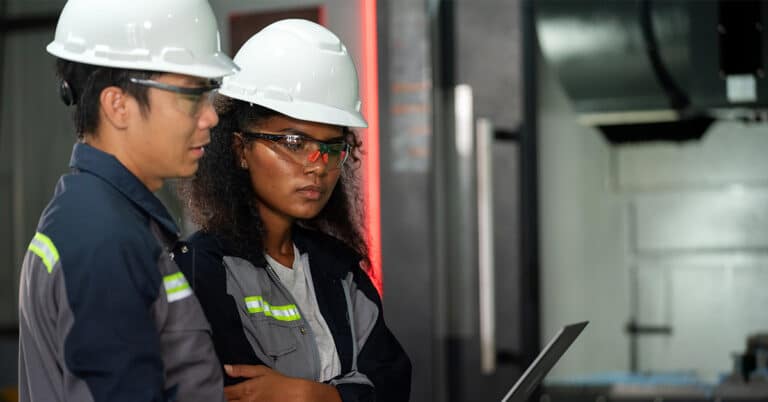After spending any time in the industrial and manufacturing fields, you quickly become aware that maintenance practices yield different results. As an extreme example, it is obvious that conducting maintenance only when it is absolutely needed — such as when equipment breaks down — is inefficient and unproductive. This is why facilities conduct regularly scheduled preventive maintenance to help eliminate emergencies and unpredictable machine failures.
You’re also likely aware that there are maintenance practices that go beyond the baseline of scheduled, preventive maintenance. One of these practices is reliability-centered maintenance.
What is reliability-centered maintenance? In some ways, the name says it all: Reliability-centered maintenance analysis focuses on keeping equipment up and running for as long as possible, while maximizing productivity and focusing maintenance efforts in the areas that will increase uptime.
Like most every aspect of maintenance, however, there is more to RCM maintenance than just the obvious. For example, there are standards for reliability-centered maintenance, developed by SAE (Society of Automotive Engineers), which can be generally applied across all industries.
These standards involve a series of questions to help identify how you can best approach reliability-centered maintenance analysis and yield optimal results, namely:
- Increased uptime
- More efficient, targeted maintenance
- Reduced maintenance costs
- Increased productivity and output
- Longer equipment life
- More insight into equipment performance
What is reliability-centered maintenance in practice?
Now that you understand the basics of a reliability-centered maintenance process, we can look at the practice in more detail. Later, we’ll also look at how to implement an RCM plan. First, we’ll cover the basics of a reliability-centered maintenance program:
- The program is designed specifically to preserve system function: This principle defines the purpose of the RCM maintenance program, which is to keep equipment functioning to spec for as long as possible. This principle zeroes in on metrics such as uptime, output and mean time between failures (MTBF).
- The RCM program identifies ways in which equipment might fail: In reliability-centered maintenance nomenclature, these are called “failure modes.” Failure modes incorporate every way in which equipment might fail — where failure is defined as operating outside the necessary specifications to achieve the desired function. “Failure,” by this definition, can include complete failure, as well as underperformance and even overperformance (which can damage equipment, increase wear and pose safety risks). Failure is also defined as any aberrational performance that causes or might cause part defects.
- The program prioritizes failure modes: As illustrated above, there are numerous types of failure modes, and they can each have different effects. An effective reliability-centered program will place these modes in an order of importance — based on how they impact the customer and the facility. Failures that lead to total equipment shutdown, for example, should be prioritized above those that might just slow down production (although these types of failures remain important). In general, a prioritization list might look something like this:
- Failure that creates a safety risk
- Failure that can damage equipment
- Failure that creates downtime
- Failure that leads to part defects
- Failure that decreases efficiency or productivity
- The program identifies potential maintenance remedies and chooses the most effective one, based on various failure modes: With an idea of which failure modes are most important, this final principle identifies potential solutions and provides guidance on the most effective course of action to address each type of failure. With this information in hand, a facility is ready to address the core issues that affect productivity and downtime.
The most effective equipment that you can have on hand to implement good reliability-centered maintenance is a CMMS (computerized maintenance management system). While it might not be considered “traditional” maintenance equipment, a CMMS is the most efficient way to track data and performance to fulfill the principles listed above — and the questions listed below, which will help you understand how to implement an RCM program.
Key components of RCM
There are three main elements that go into a typical RCM plan:
1. Functional failure analysis: This is the process of determining all the ways in which a specific piece of equipment can fail to perform up to expectations. These can range from very simple, such as a single bearing wearing down due to lack of lubrication, all the way up to complete system failures that have multiple causes.
2. Failure modes and effects analysis (FMEA): Once it is determined how equipment might fail, the next step is identifying which potential failures should be prioritized when it comes to maintenance and asset management. This can be broken down further into design failure mode and effect analysis (DFMEA) and process failure mode and effects analysis (PFMEA). DFMEA is a version of the process that is used during the design of machinery, while PFMEA is used to identify potential failures within a manufacturing process.
3. Maintenance task selection: Based on a comprehensive failure analysis, operators have all the information they need to select the most appropriate maintenance tasks to help them avoid the most likely scenarios. This enables them to concentrate their efforts on the areas where they have the greatest chance to enhance productivity and prevent failures throughout their processes.
Implementing a maintenance reliability program
The best way to implement RCM has been identified by SAE in the standard SAE JA1012 and is outlined via seven questions. These questions should be applied once you’ve identified your most critical equipment via the four principles above — i.e., the equipment that is most important to keep running so operations stay on track.
This equipment might be an injection molding machine, or it might be a material handling conveyor — it all depends on your individual facility. Once you’ve identified that equipment, apply these questions:
What is the equipment supposed to do and what are its associated performance standards? This question enables you to set a baseline performance benchmark for your critical equipment.
In what ways can it fail to provide the required functions? To answer this question, apply the failure mode analysis discussed above — identifying every way in which your critical equipment can possibly fail.
What are the events that cause each failure? This question requires you to take a step back and analyze what can lead to each type of failure. Is it missed or delayed maintenance? Erroneous machine operation? Subpar replacement components?
What happens when each failure occurs? This question is intended to look at the “domino effects” that each type of failure can cause. Does the failure lead to unplanned downtime? Costly emergency part orders? Safety risks to personnel or the end-user?
In what way does each failure matter? With an understanding of potential failure types, this question urges you to look at the lasting effects of each failure. Examples of ways in which failures matter include missed deadlines, unsatisfied customers, safety violations, shortened equipment life span, increased maintenance costs and more.
What systematic tasks can be performed proactively to prevent or diminish the consequences of the failure? When answering this question, look at the events that led to each type of failure. From there, identify the proactive actions that you can take to address these events. Some ideas — depending on the type of failure — include improved or increased training, new part suppliers, and more frequent maintenance.
What must be done if a suitable preventive task cannot be found? This question requires out-of-the-box thinking, encouraging you to create alternate or contingency plans if preventive tasks are not feasible.
Benefits of reliability-centered maintenance
Adopting RCM practices in your facility can bring numerous advantages, including:
- Increased reliability: By focusing your efforts on the most critical maintenance tasks, you can improve the overall reliability of your equipment and prevent costly downtime.
- Cost efficiency: When you experience fewer failures and more uptime, you can achieve significant cost savings and prevent waste throughout your operations.
- Enhanced safety: One of the most important benefits of RCM is how it can prevent critical equipment failures that can place employees and other assets at risk.
One solution, which is proactive and innovative, is working with a contract maintenance partner. At ATS, our Comprehensive Maintenance Solution applies our decades of reliability expertise, best-in-class process standards, and technology-driven platforms and analytics to seamlessly implement reliability-centered maintenance across our customer’s factories. All so they can lower maintenance costs, increase productivity and output, improve asset health, and focus on core competencies.
For more information, contact us today.






